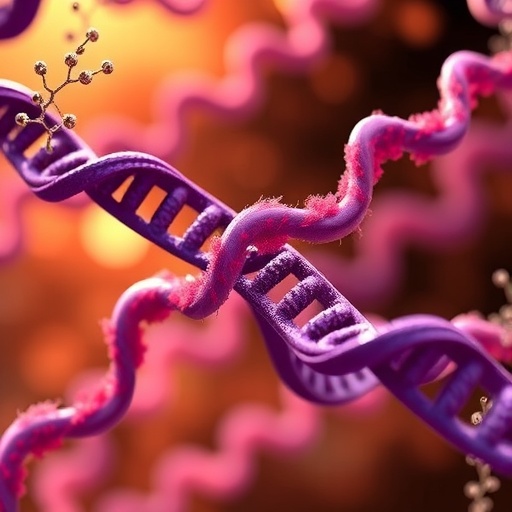In a groundbreaking study recently published in Cell Death Discovery, scientists have unveiled a novel mechanism by which cancer cell proliferation can be selectively impaired—through RNA-mediated inhibition of a mitochondrial enzyme known as serine hydroxymethyltransferase 2 (SHMT2). This revelation not only deepens our understanding of cancer metabolism but also opens promising avenues for targeted anticancer therapies, potentially ushering in a new era of mitochondrial-focused interventions in oncology.
SHMT2, a mitochondrial enzyme critical for one-carbon metabolism, plays a pivotal role in serine metabolism and nucleotide biosynthesis within the mitochondria. Its function is intimately tied to the synthesis of building blocks indispensable for rapidly dividing cells, such as cancer cells. By facilitating the interconversion of serine to glycine and generating one-carbon units, SHMT2 supports DNA replication, repair processes, and overall metabolic adaptability, cornerstones for cancer cell survival and expansion.
The research team led by Liberati et al. employed advanced RNA interference technologies to specifically target and suppress SHMT2 in a variety of cancer cell lines. Their rigorous experiments demonstrated that downregulation of mitochondrial SHMT2 notably curtailed cellular proliferation rates, effectively stalling tumor cell growth. What sets this approach apart is its precision—leveraging the inherent specificity of RNA molecules to disrupt mitochondrial enzyme function without broadly impairing other cellular processes.
.adsslot_s2794liDzo{ width:728px !important; height:90px !important; }
@media (max-width:1199px) { .adsslot_s2794liDzo{ width:468px !important; height:60px !important; } }
@media (max-width:767px) { .adsslot_s2794liDzo{ width:320px !important; height:50px !important; } }
ADVERTISEMENT
Central to this study was the exploitation of RNA species to achieve mitochondrial enzyme inhibition. Previously, mitochondrial enzymes posed significant challenges for direct targeting, owing to the organelle’s double-membrane structure and its distinct genetic code. By harnessing RNA molecules designed to interfere with SHMT2 expression or activity within mitochondria, the researchers overcame these traditional obstacles, achieving a level of organelle-specific biochemical modulation rarely seen before.
Further analyses revealed that the inhibition of SHMT2 led to a dramatic imbalance in mitochondrial one-carbon metabolism. The depletion of one-carbon units disrupted the synthesis of nucleotides necessary for DNA replication, triggering cellular stress responses that ultimately culminated in the suppression of tumor growth. Additionally, these perturbations induced metabolic bottlenecks that cancer cells were unable to circumvent, underscoring the vulnerability of their metabolic wiring.
Importantly, the suppression of cancer cell proliferation was not accompanied by widespread cytotoxicity, suggesting a therapeutic window wherein mitochondrial SHMT2 inhibition might selectively target malignant cells while sparing normal tissue. This selective toxicity is a critical consideration in anticancer drug development, where minimizing collateral damage remains a formidable challenge.
The investigation also delved into the interplay between SHMT2 activity and cellular redox balance. SHMT2 contributes indirectly to the generation of NADPH, a key molecule in combating oxidative stress. By impairing SHMT2, cancer cells exhibited increased oxidative damage, sensitizing them to cellular apoptosis. This dual effect—metabolic disruption coupled with elevated oxidative stress—amplifies the potential efficacy of SHMT2-targeted strategies.
To validate their findings, the authors conducted in vivo experiments using mouse xenograft models implanted with human cancer cells exhibiting SHMT2 inhibition. The results confirmed that tumors with reduced SHMT2 activity grew significantly slower, translating in some cases to tumor regression. These animal studies provide vital proof-of-concept support for the development of SHMT2-targeted treatments in clinical settings.
Moreover, the study highlights the broader implications of mitochondrial metabolism in cancer biology. It challenges the traditional glycolysis-centric view of cancer metabolism by emphasizing the indispensable role of mitochondrial enzymatic pathways. This paradigm shift accentuates mitochondria not merely as energy producers but as dynamic regulators of biosynthetic and redox networks critical for tumor progression.
In light of these insights, potential therapeutic modalities might include synthetically engineered RNA molecules or small interfering RNAs designed to accumulate within mitochondria, selectively knocking down SHMT2 expression. This precision medicine approach aligns with recent advances in RNA therapeutics, which have gained momentum thanks to improved delivery platforms and chemical modifications enhancing RNA stability and cellular uptake.
The ramifications extend beyond therapy development; understanding SHMT2’s role could also inform biomarker discovery. Levels of SHMT2 expression or the integrity of mitochondrial one-carbon metabolism might serve as diagnostic indicators or predictors of treatment response in various cancers. Integrating metabolic profiling into clinical oncology practice might therefore refine patient stratification and optimize personalized treatment regimens.
Additionally, the study offers fresh perspectives regarding mitochondrial dynamics in tumorigenesis. By connecting RNA-mediated enzymatic inhibition to functional mitochondrial impairment, these findings underscore how mitochondrial dysfunction can be strategically harnessed against cancer cells. This represents a fertile ground for collaboration across molecular biology, bioinformatics, and clinical research disciplines aiming to translate these discoveries into tangible health benefits.
Future research will undoubtedly explore the molecular intricacies governing RNA import into mitochondria, specificity determinants of SHMT2 targeting, and potential resistance mechanisms that cancer cells might deploy. Addressing these questions is imperative to realizing the translational potential of RNA-driven mitochondrial interventions, particularly in heterogeneous tumor microenvironments.
As the landscape of cancer treatment evolves, the intersection of RNA technology and mitochondrial biology epitomizes a frontier ripe for innovation. By disrupting crucial mitochondrial enzymes like SHMT2 through RNA-based methods, researchers are charting a course toward sophisticated, highly selective interventions poised to outmaneuver cancer’s adaptive prowess. This study thus represents a beacon of hope and a call to action for intensified investigation into RNA-mediated modulation of cancer metabolism.
The synergy of advances in mitochondrial targeting, RNA chemistry, and cancer cell metabolism elucidated by this study paves the way for next-generation therapies that can transcend the limitations of conventional treatments. Harnessing this knowledge could ultimately lead to more effective, less toxic cancer therapeutics that improve patient outcomes and quality of life, epitomizing the future of personalized medicine.
Subject of Research: RNA-mediated inhibition of mitochondrial SHMT2 and its effects on cancer cell proliferation.
Article Title: RNA-mediated inhibition of mitochondrial SHMT2 impairs cancer cell proliferation.
Article References:
Liberati, F.R., Spizzichino, S., Di Russo, S. et al. RNA-mediated inhibition of mitochondrial SHMT2 impairs cancer cell proliferation. Cell Death Discov. 11, 369 (2025). https://doi.org/10.1038/s41420-025-02646-y
Image Credits: AI Generated
DOI: https://doi.org/10.1038/s41420-025-02646-y
Tags: cancer cell proliferation mechanismscancer metabolism research breakthroughsmetabolic adaptation in cancer cellsmitochondrial enzyme inhibitionmitochondrial-focused oncology interventionsone-carbon metabolism in cancerRNA interference technologyRNA-mediated cancer treatment strategiesselective impairment of tumor growthserine hydroxymethyltransferase 2SHMT2 role in cancertargeted anticancer therapies





